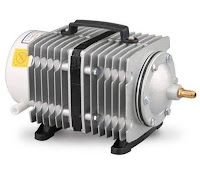Tank types used in Biofloc Farming:
Moving forward towards the construction of tanks for fish farming, the first question that pops in our mind is the type of tank and the material to be used for constructing the tank. Although there are tanks which are constructed using different materials, but usually Biofloc tanks are of two types:
- Tarpaulin tanks
- Cement or concrete tanks
These are the widely used materials for tanks, largely accepted by around 85 percent of fish farmers. Most of them use tarpaulin tanks, and if you ask for advice, they'll start praising tarpaulin for numerous real and/or fictional advantages. There are several reasons behind tarpaulin becoming the favourite option for so many of us. But we need to understand why and how tarpaulin became the "favourite child" for so many of them.
If you think about it, you'll realize that this fish farming technology was introduced in Israel, as space and water is not that abundant in Israel. So this technology was gladly accepted by the masses with open arms. Since concrete and raw materials are comparatively costlier over there, so they came up with the idea of using tarpaulin, which is waterproof and cost-effective. Later in, Indonesia was the country that adopted this biofloc fish farming technology and literally copied everything from farmers of Israel to the t, i.e. circular tarpaulin tank.
Let's talk about India, we blindly followed the mass and unofficially declared that Biofloc fish farming is done only in tarpaulin tanks, and this is totally wrong. Fish farming can be done in any tank made of any waterproof material, whether it is tarpaulin or PVC or concrete. Because of several YouTubers, people blindly believe that tarpaulin tanks helps in better fish production, and they cannot be more wrong.
Coming back to the point, tanks are usually constructed by the two above-mentioned materials, each with their own set of pros and cons.
Please note: This post may contain Affiliate links. It would be highly appreciated if you please consider buying from the links provided. It won't cost you anything extra, but it may help us with a little bit of commission from Amazon.
Tarpaulin :
Tarpaulin, like I've already said, is the most widely used material for construction of the tanks.
Advantages of Tarpaulin: |
Tarpaulin tank
|
- Cheaper in price when compared to cement tanks. They can be completed under Rs. 15,000/- in India.
- Easily available in online markets, but you have to be careful in choosing the material of the right thickness, otherwise you're going to be in a big trouble.
- They are lighter in weight, so when they're empty they can be moved from one site to another.
- Some manufacturers also provide total replacement warranty of around 3-5 years, so you will be a little bit less worried about their longevity.
Disadvantages of Tarpaulin:
- No matter how thick the material is, tarpaulin is still not a damage proof material. As I have seen in my case, they can be very easily damaged if they're not installed by professionals.
- They are not very very long-lasting no matter how much the seller or manufacturer says. The average life of a tarpaulin tanks is no more than a few years.
- Repair is possible, but if there is a very minute tear in the tank while it is loaded, then you'd have to act fast otherwise you have to look for a spare tank that may hold your fishes while you're repairing it.
- Most manufacturers do not know about the proper thickness of the tarpaulin. They also do not care about the tarpaulin whether they're UV stabilized or not. Choosing the wrong type of tarpaulin can be harmful from the fishes, because over time they affect the water and the fishes.
- In summer the water gets terribly hot because the temperature can easily cross the 45 ℃ mark in India summers
Please note: This post may contain Amazon Affiliate links. It would be highly appreciated if you please consider buying from the links provided. It won't cost you anything extra, but it may help us with a little bit of commission from Amazon.
Concrete or cement tanks :
When this technology was introduced to India, many farmers were unable to get their hands on the proper type of tarpaulin for their tanks, so with a little bit of consideration, they started constructing tanks using cement. I am one of those fish farmers who prefer concrete tanks over tarpaulin tanks.  |
| Cement tank |
Advantages of concrete tanks:
- These tanks are highly durable and used mainly for their water holding strength.
- They last really really long. With proper maintenance, one concrete tank will easily last for at least two decades, hence these are cost-effective in the long run.
- I have noticed that the temperature of the water in the cement tank is always around 5-7℃ lower, so I assume they keep the water a bit cooler.
Disadvantages of concrete tanks:
- Costlier than tarpaulin tanks. The initial investment would easily cross Rs. 30,000/- in India, which can be a bit tougher for new farmers.
- The cannot be relocated to any other site.
- Although these tanks made of cement are damage-proof up to a great extent, but in case of any damage it will require a little bit longer.
| Parameters | Cost | Mobility | Strength | Durability | Time for construction |
| Tarpaulin | ★★ | ★★★★ | ★★ | ★ | ★ |
| Concrete | ★★★★ | - | ★★★★★ | ★★★★★ | ★★★ |
These are the two major types of materials used for constructing of Biofloc tanks. I have included words from my own experience. I hope you don't mind me babbling about certain stuff.


























